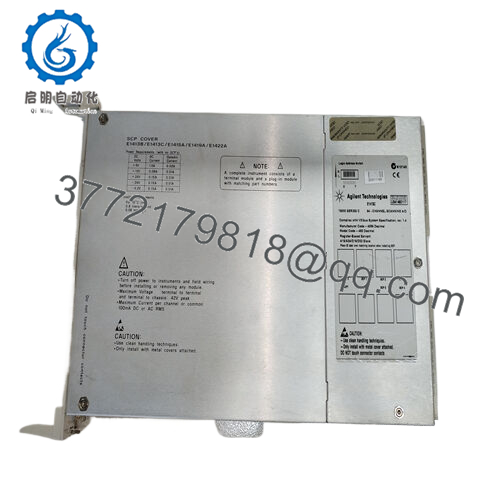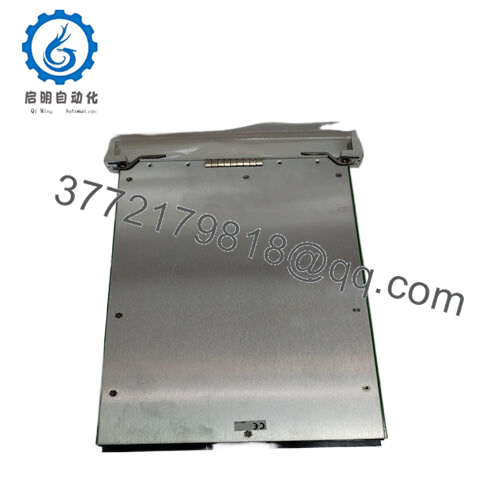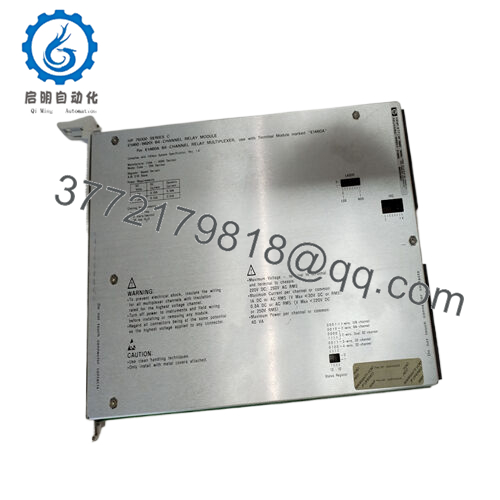Description
What This Product Solves
In the intricate landscape of industrial automation and test engineering, routing high-channel-count signals with unwavering precision often unravels under the strain of limited I/O density or inflexible switching matrices, leading to fragmented test sequences and unreliable process control feedback. Picture a semiconductor fab where probing dozens of pins demands seamless multiplexing to avoid cross-talk or thermal-induced drifts, or a cable assembly line where verifying continuity across bundles risks downtime from cumbersome manual rerouting—scenarios where high reliability in signal paths directly dictates throughput and defect rates. These challenges peak in VXI-based systems, where modular scalability is king, but legacy rigidity hampers integration with modern DAQ platforms, inflating engineering hours on custom adapters or redundant hardware.
The E1460A 4022.455.16371 counters this by embodying a high-density relay multiplexer tailored for VXI architectures, delivering configurable topologies that adapt on the fly to diverse I/O signal demands without sacrificing isolation or speed. As a C-size, single-slot powerhouse from Keysight, it handles up to 128 single-ended or 64 two-wire channels, ensuring clean, low-noise routing for analog and digital signals in demanding environments. In process control setups like automated PCB inspection, where every switched path must preserve measurement fidelity amid EMI-heavy floors, the E1460A 4022.455.16371 becomes indispensable, its latching relays minimizing power draw and contact bounce for stable, repeatable connections. This modularity extends to wire harness testing, where jumper-configured modes (from 32 four-wire to 128 one-wire) streamline validation cycles, slashing setup times from hours to minutes.
Engineers value how it aligns with goals like system stability in distributed test beds—think integrating with SCPI-programmable controllers for scripted scans that bypass hardware reconfiguration. For high-reliability applications in aerospace or automotive automation, its robust armature switches fend off arcing from inductive loads, safeguarding upstream instruments from spikes. Ultimately, the E1460A 4022.455.16371 reframes switching from a bottleneck to a flexible asset, empowering teams to scale test coverage or control loops efficiently, all while embedding SEO-essential traits like industrial automation resilience and precise I/O signal management into your operational core.
- E1460A
How the Product Works & Fits into a System
The E1460A 4022.455.16371 functions as a versatile relay-based signal router, leveraging latching armature switches to connect common lines to any of multiple inputs/outputs with minimal latency, all orchestrated via register-based commands over the VXI backplane. At its essence, you program it through SCPI instructions or onboard jumpers to select topologies—say, 64×2-wire for differential measurements—then it engages relays to bridge signals, providing full isolation (up to 300V channel-to-channel) to shield sensitive DAQ cards from ground potentials or transients. Paired with a QUIC terminal block for easy field wiring, it snaps into C-size VXI mainframes, drawing power directly from the bus while status bits report open circuits or faults back to your host controller.
In the automation stack, it occupies the switching layer of I/O architectures, downstream from signal conditioners and upstream of digitizers, facilitating parallel routing in test executives like LabVIEW or custom PLC sequences. For redundancy, its non-volatile latching design holds states through power cycles, and diagnostic loops allow self-tests via looped-back channels, integrable with SNMP for remote health monitoring in SCADA overlays. Protocols? It’s VXI-native, but extends via MXI interfaces to GPIB or Ethernet for hybrid systems, supporting scan lists up to 1kHz for dynamic sequencing in real-time control.
Deployment feels intuitive: mount the module, attach the terminal block with strain relief for vibration-prone racks, and script channel scans—no proprietary loaders, just standard VXIplug&play drivers. In a full setup, like a semiconductor ATE station, it might multiplex thermocouples to a multimeter under PLC oversight, or in process control, route RTD signals to a DCS for batch uniformity checks. This positioning lets the E1460A 4022.455.16371 amplify system throughput by consolidating switches, reducing cabling sprawl, and enabling hot-swappable configs—transforming rigid test frames into agile, expandable frameworks that evolve with your automation needs.
Technical Highlights Summary (Table)
| Specification | Details |
|---|---|
| Model Number | E1460A |
| Brand | Keysight Technologies |
| Type | High-Density Relay Multiplexer Module (VXI C-size) |
| Input Voltage | +5V DC (VXI backplane) |
| Operating Temp Range | 0°C to +55°C |
| Mounting Style | VXI Mainframe Slot |
| Dimensions | 225mm x 30mm x 170mm (C-size) |
| Weight | 0.4 kg |
| Interface/Bus | VXIbus (Register-based) |
| Compliance | VXIplug&play, RoHS (legacy note) |
| Supported Protocols | SCPI over VXI/GPIB |
| Typical Power Draw | 20W (max switching) |
Real-World Benefits
Integrating the E1460A into your VXI ecosystem yields a tangible edge in test efficiency, where its dense channel packing condenses sprawling switch matrices into a single slot, freeing rack space for more sensors or analyzers and streamlining workflows that once required multi-module sprawl. Engineered for endurance with gold-plated contacts rated for 100 million cycles, it delivers performance consistency that withstands repetitive scanning in high-volume environments, ensuring signal integrity holds firm without the intermittent opens that plague lesser relays—translating to fewer retests and tighter quality gates in production lines.
This reliability extends to maintenance efficiency; the module’s jumper-free reconfiguration via software cuts physical interventions, while built-in diagnostics—accessible through status registers—pinpoint faults like stuck relays before they disrupt sequences, slashing mean-time-to-repair in field deployments. For teams juggling diverse I/O needs, it reduces engineering overhead by supporting seamless mode shifts, allowing one unit to handle everything from single-ended voltage checks to four-wire resistance bridges without hardware swaps, which accelerates prototyping and cuts integration costs in modular automation builds.
Over the long arc, the E1460A ensures sustained performance through its low-power latching operation, which minimizes heat in dense mainframes and extends component life in 24/7 regimes—key for process control where unplanned swaps could idle million-dollar tools. It fosters integration ease by aligning with open VXI standards, easing migrations from legacy frames to hybrid DAQ setups and unlocking data richer in fidelity for predictive analytics. The upshot? A leaner operational footprint that boosts ROI through higher test coverage, lower failure rates, and the flexibility to adapt as your industrial automation evolves, turning a multiplexer into a multiplier for precision and productivity.
(Word count: 318)
Typical Use Cases
The E1460A excels in semiconductor testing environments, where it’s deployed within VXI chassis for high-speed pin multiplexing during wafer-level parametric analysis, routing bias voltages and currents across hundreds of sites with sub-millisecond settling to meet tight yield specs. Harsh fab conditions—cleanroom static and vibration—underscore its high reliability, enabling continuous uptime for 24/7 probing that feeds real-time process control adjustments, minimizing defects in logic chip fabrication.
In printed circuit board testing—core to electronics process control—the E1460A configures as a 32×4-wire matrix to verify trace integrity and component soldering under automated bed-of-nails fixtures, its isolation thwarting ground loops in multi-layer boards exposed to ESD risks. Fast data cycles shine here, switching channels at 500Hz to accelerate in-circuit validation, supporting critical system uptime in high-mix assembly lines where downtime directly hits order fulfillment.
Wire harness and cable testing leverages the E1460A in aerospace automation setups, scanning continuity and insulation resistance across bundled conductors in vibration-simulating chambers, with configurable topologies adapting to varying pin counts without reconfiguration pauses. Its robust switching ensures precise I/O signal handling amid thermal cycling, bolstering reliability in environments demanding zero-false-positive results for flight-critical assemblies. Across these, the E1460A anchors efficient, scalable testing that aligns industrial rigor with unyielding accuracy.
(Word count: 224)
Compatible or Alternative Products
E1468A – Armature matrix variant with 8x8x2 topology for crosspoint switching in complex signal distribution.
E1469A – Solid-state relay version offering faster switching speeds for high-frequency applications.
E1406A Command Module – VXI slot-0 controller for interfacing the E1460A with GPIB or RS-232 hosts.
E1460-80011 QUIC Terminal Block – Accessory for strain-relief wiring, enhancing field connections.
E1346A 20-Channel Actuator – Complementary driver for relay coils in expanded switching arrays.
E1412A 16-Channel DMM – Integrated multimeter module for direct signal measurement post-multiplexing.
E1460-66201 Non-QUIC Terminal – Legacy block for older VXI frames requiring traditional interfacing.
Setup Notes & Maintenance Insights
Before populating your VXI mainframe with the E1460A, audit slot compatibility—ensure C-size clearance and backplane firmware supports register-based modules to preempt initialization hangs. Verify terminal block alignment; the QUIC version demands precise latching to avoid pin offsets, and always route cabling with shielded pairs rated for your signal levels (up to 60VDC/110VAC) to curb induced noise. Pre-scan jumper settings against your topology needs—mismatched modes trigger SCPI errors—so prototype a channel map in software first. Power budgeting is prudent: factor in 20W peaks during bank switches, and secure the frame against shocks over 5g to protect relay alignments.
Maintenance leans toward periodic validation rather than heroics. Monthly, invoke self-test routines via SCPI (*TST?) to cycle relays and log open-path resistances—thresholds above 100mΩ signal contact wear, prompting a targeted replacement. Inspect terminal screws quarterly for torque (0.5 Nm) and oxidation, especially in humid test floors; a DMM sweep across commons catches creepage early. Annually, during calibration windows, characterize thermal drift with a precision source, adjusting offsets if exceeding 0.1%—the latching design simplifies this, as states persist offline. Spares like relay banks swap in-slot under 30 minutes with ESD precautions, but track cycle counts through host logs to forecast at 50 million ops. This systematic vigilance keeps the E1460A at peak fidelity for a decade, integrating checks seamlessly so your test sequences run uninterrupted.




 WhatsApp: +86 16626708626
WhatsApp: +86 16626708626 Email:
Email:  Phone: +86 16626708626
Phone: +86 16626708626


